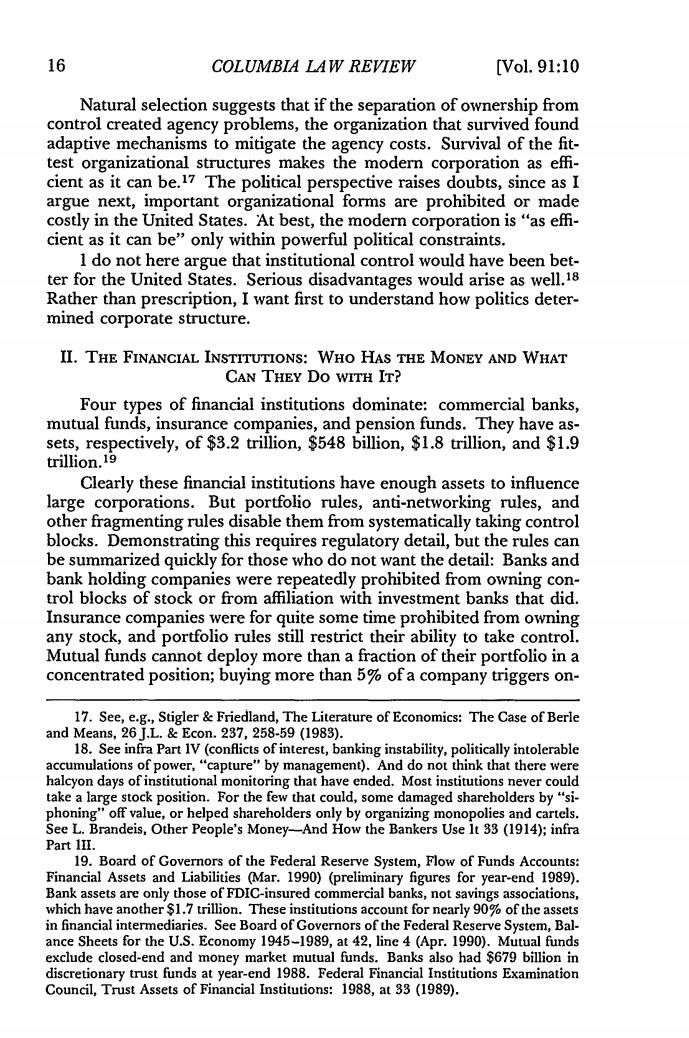正在加载图片...

16 COLUMBIA LAW REVIEW [Vol.91:10 Natural selection sugge adaptive mechanisms to mitigate the agency costs.Survival of the fit- test organizational structures makes the modern corporation as effi- cient as it can be.17 The political perspective raises doubts,since as I argue next in anizational form At best,th d States rn corporation is cient as it can be"only within powerful political constraints. 1 do not here argue that institutional control would have been bet- ter for the United States.Serious disadvantages would arise as well.8 Rather than prescription,I want first to understand d how politics dete mined corporate structure. II.THE FINANCIAL INSTITUTIONS:WHO HAS THE MONEY AND WHAT CAN THEY DO WITH ITP pes of financial institutions dominate: mutual fun ension funds ercial banks, They have as sets respectively,of $2 trillion,54 billion,$18 trillion,and trillion. Clearly these financial institutions have enough assets to influence orporati ons.But rules anti-n ng contro. blocks.Demonstrating this requires regulatory detail,but the rules can be summarized quickly for those who do not want the detail:Banks and bank holding companies were repeatedly prohibited from owning con- trol blocks of stock or from affiliation with investment banks that did. Insurance companies r q uite so e pr hibi ed fro nds mt eploymors hanrt o o rules still restrict their abili contro concentrated position;buying more than 5%of a company triggers on- er&Friedland,The Literature of Economics:The Case of Berle 19 18.See infra Part IV (conflicts of inter st,banking instability,politically intolerable accumulations of power,"capture"by management).And do not think that there were tional monitoring that ha e ended.Most institutions never coul k position.Fo the fe that cou d,some damaged shar lders by See L.Brandeis.Other P -And Ho oh Ban Part III. 19.Board of Govern s of the Federal Reserve System,Flow of Funds Accounts: gures for year-end 1989) ot sa 0 of the as in financial intermediaries.See Board of Governors of the Federal Reserve System,Bal- ance Sheets for the U.S.Economy 1945-1989,at 42,line 4 (Apr.1990).Mutual funds nd money market Ban also had 679 bilhon m Fed ina33(1989 tutions Examinatio】COLUMBIA LAW REVIEW Natural selection suggests that if the separation of ownership from control created agency problems, the organization that survived found adaptive mechanisms to mitigate the agency costs. Survival of the fittest organizational structures makes the modem corporation as efficient as it can be. 17 The political perspective raises doubts, since as I argue next, important organizational forms are prohibited or made costly in the United States. At best, the modem corporation is "as efficient as it can be" only within powerful political constraints. I do not here argue that institutional control would have been better for the United States. Serious disadvantages would arise as well.' 8 Rather than prescription, I want first to understand how politics determined corporate structure. II. THE FINANCIAL INSTITUTIONS: WHO HAS THE MONEY AND WHAT CAN THEY Do wiTH IT? Four types of financial institutions dominate: commercial banks, mutual funds, insurance companies, and pension funds. They have assets, respectively, of $3.2 trillion, $548 billion, $1.8 trillion, and $1.9 trillion. 19 Clearly these financial institutions have enough assets to influence large corporations. But portfolio rules, anti-networking rules, and other fragmenting rules disable them from systematically taking control blocks. Demonstrating this requires regulatory detail, but the rules can be summarized quickly for those who do not want the detail: Banks and bank holding companies were repeatedly prohibited from owning control blocks of stock or from affiliation with investment banks that did. Insurance companies were for quite some time prohibited from owning any stock, and portfolio rules still restrict their ability to take control. Mutual funds cannot deploy more than a fraction of their portfolio in a concentrated position; buying more than 5% of a company triggers on- 17. See, e.g., Stigler & Friedland, The Literature of Economics: The Case of Berle and Means, 26J.L. & Econ. 237, 258-59 (1983). 18. See infra Part IV (conflicts of interest, banking instability, politically intolerable accumulations of power, "capture" by management). And do not think that there were halcyon days of institutional monitoring that have ended. Most institutions never could take a large stock position. For the few that could, some damaged shareholders by "siphoning" off value, or helped shareholders only by organizing monopolies and cartels. See L. Brandeis, Other People's Money-And How the Bankers Use It 33 (1914); infra Part III. 19. Board of Governors of the Federal Reserve System, Flow of Funds Accounts: Financial Assets and Liabilities (Mar. 1990) (preliminary figures for year-end 1989). Bank assets are only those of FDIC-insured commercial banks, not savings associations, which have another $1.7 trillion. These institutions account for nearly 90o of the assets in financial intermediaries. See Board of Governors of the Federal Reserve System, Balance Sheets for the U.S. Economy 1945-1989, at 42, line 4 (Apr. 1990). Mutual funds exclude closed-end and money market mutual funds. Banks also had $679 billion in discretionary trust funds at year-end 1988. Federal Financial Institutions Examination Council, Trust Assets of Financial Institutions: 1988, at 33 (1989). [Vol. 91:10